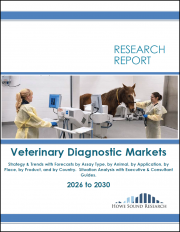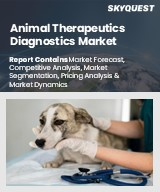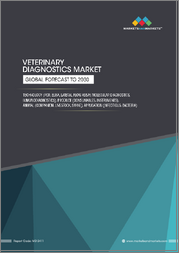
|
시장보고서
상품코드
1630733
가축 진단 시장 규모, 점유율, 성장 분석 : 제품별, 기술별, 동물 유형별, 최종사용자별, 지역별 - 산업 예측(2025-2032년)Livestock Diagnostics Market Size, Share, Growth Analysis, By Product (Consumables, Systems), By Technology (Immunodiagnostics, Molecular Diagnostics), By Animal Type, By End User, By Region - Industry Forecast 2025-2032 |
||||||
세계의 가축 진단 시장 규모는 2023년에 14억 달러로 평가되며, 2024년 15억 2,000만 달러에서 2032년에는 29억 4,000만 달러로 성장하며, 예측 기간(2025-2032년)의 CAGR은 8.6%로 성장할 전망입니다.
가축 진단 시장은 병원균을 식별하고 동물의 건강을 확인하는 데 필수적이며, 유망한 성장 기회를 목격하고 있습니다. 다양한 유형의 동물의 조직, 혈액, 분변을 분석함으로써 동물병원과 참조 실험실을 포함한 전체 부문에서 질병의 조기 발견과 관리를 촉진합니다. 전염병으로 인한 생산 손실에 대한 인식이 높아지고, 전염병 진단을 목표로 하는 노력이 시장 확대를 촉진하고 있습니다. 선진 지역에서는 수의사 수 증가, 소득 수준 향상, 질병 예방 조치 강화 등의 요인이 이러한 성장에 크게 기여하고 있습니다. 또한 첨단 진단 기술의 도입으로 수의학적 진단 및 치료 효율의 향상을 약속하며, 시장 경쟁력 유지와 시장 지위 강화를 위한 지속적인 기술 혁신이 가능합니다.
목차
서론
- 조사의 목적
- 조사 범위
- 정의
조사 방법
- 정보 조달
- 2차 데이터와 1차 데이터 방법
- 시장 규모 예측
- 시장의 전제조건과 제한
개요
- 세계 시장 전망
- 공급과 수요의 동향 분석
- 부문별 기회 분석
시장 역학과 전망
- 시장 개요
- 시장 규모
- 시장 역학
- 촉진요인과 기회
- 억제요인과 과제
- Porter의 산업 분석
주요 시장 인사이트
- 주요 성공 요인
- 경쟁의 정도
- 주요 투자 기회
- 시장 에코시스템
- 시장의 매력 지수(2024년)
- PESTEL 분석
- 거시경제 지표
- 밸류체인 분석
- 가격 분석
- 사례 연구 분석
가축 진단 시장 규모 : 제품별
- 시장 개요
- 소모품
- 소 바이러스성 설사증(BVD)
- 인플루엔자
- 조류인플루엔자
- 돼지 인플루엔자
- 기타 인플루엔자
- 구제역(FMD)
- 브르탕(BTV)
- 소 결핵(TB)
- 소 헤르페스 바이러스(BHV)
- 돼지 번식 호흡기 증후군(PRRS)
- 뉴캐슬병
- 조류 마이코플라스마
- 기타 질병
- 시스템
- 소프트웨어
가축 진단 시장 규모 : 기술별
- 시장 개요
- 면역진단
- 효소 면역측정법(ELISA) 검사
- 기타 면역진단 검사
- 분자진단
- 중합효소 연쇄 반응(PCR) 검사
- 기타 분자진단 검사
- 기타 테크놀러지
가축 진단 시장 규모 : 동물 유형별
- 시장 개요
- 반추동물
- 소 동물
- 기타 반추동물
- 돼지
- 가금
- 기타 동물
가축 진단 시장 규모 : 최종사용자별
- 시장 개요
- 표준실험실
- 진단 병원 및 진료소
- POC(Point-of-care) 검사
가축 진단 시장 규모
- 북미
- 미국
- 캐나다
- 유럽
- 독일
- 스페인
- 프랑스
- 영국
- 이탈리아
- 기타 유럽 지역
- 아시아태평양
- 중국
- 인도
- 일본
- 한국
- 기타 아시아태평양
- 라틴아메리카
- 브라질
- 기타 라틴아메리카 지역
- 중동 및 아프리카
- GCC 국가
- 남아프리카공화국
- 기타 중동 및 아프리카
경쟁 정보
- 상위 5사의 비교
- 주요 기업의 시장 포지셔닝(2024년)
- 주요 시장 기업이 채택한 전략
- 시장의 최근 동향
- 기업의 시장 점유율 분석(2024년)
- 주요 기업의 기업 개요
- 회사 개요
- 제품 포트폴리오 분석
- 부문별 점유율 분석
- 매출의 전년대비 비교(2022-2024)
주요 기업 개요
- IDEXX Laboratories Inc.(US)
- Neogen Corporation(US)
- Zoetis Inc.(US)
- Thermo Fisher Scientific Inc.(US)
- Virbac SA(France)
- IDvet(France)
- Bio-Rad Laboratories, Inc.(US)
- GD Animal Health(Netherlands)
- Agrolabo Spa(Italy)
- BioMerieux SA(France)
- Boehringer Ingelheim Vetmedica, Inc.(Germany)
- Randox Laboratories Ltd.(UK)
- ABAXIS, Inc.(US)
- Anigenics Inc.(US)
- Bionote, Inc.(South Korea)
- Eurofins Scientific SE(Luxembourg)
- VCA Inc.(US)
- Agriprotein(South Africa)
결론과 권장사항
KSA 25.02.24Global Livestock Diagnostics Market size was valued at USD 1.4 billion in 2023 and is poised to grow from USD 1.52 billion in 2024 to USD 2.94 billion by 2032, growing at a CAGR of 8.6% during the forecast period (2025-2032).
The livestock diagnostics market, integral for pathogen identification and animal health confirmation, is witnessing promising growth opportunities. By analyzing tissue, blood, and feces from various animal types, these diagnostics facilitate early disease detection and management across sectors including veterinary clinics and reference labs. Increased awareness of production losses from infectious diseases, alongside initiatives targeting infection diagnosis, are propelling market expansion. In developed regions, factors such as a rising number of veterinary practitioners, higher income levels, and enhanced disease prevention measures significantly contribute to this growth. Additionally, the introduction of advanced diagnostic technologies promises to improve veterinary diagnoses and treatment efficiency, allowing market players to leverage continuous innovation for sustained competitive advantage and stronger market positions.
Top-down and bottom-up approaches were used to estimate and validate the size of the Global Livestock Diagnostics market and to estimate the size of various other dependent submarkets. The research methodology used to estimate the market size includes the following details: The key players in the market were identified through secondary research, and their market shares in the respective regions were determined through primary and secondary research. This entire procedure includes the study of the annual and financial reports of the top market players and extensive interviews for key insights from industry leaders such as CEOs, VPs, directors, and marketing executives. All percentage shares split, and breakdowns were determined using secondary sources and verified through Primary sources. All possible parameters that affect the markets covered in this research study have been accounted for, viewed in extensive detail, verified through primary research, and analyzed to get the final quantitative and qualitative data.
Global Livestock Diagnostics Market Segmental Analysis
Global Livestock Diagnostics Market is segmented by Product, Technology, Animal Type, End User and region. Based on Product, the market is segmented into Consumables, Systems and Software. Based on Technology, the market is segmented into Immunodiagnostics, Molecular Diagnostics and Other Technologies. Based on Animal Type, the market is segmented into Ruminants, Swine, Poultry and Other Animals. Based on End User, the market is segmented into Reference Laboratories, Diagnostic Hospitals & Clinics and Point-of-care (POC) Testing. Based on region, the market is segmented into North America, Europe, Asia Pacific, Latin America and Middle East & Africa.
Driver of the Global Livestock Diagnostics Market
The Global Livestock Diagnostics market is witnessing significant growth, primarily fueled by the increasing demand for food products derived from livestock. This surge is accompanied by a growing incidence of food-borne and zoonotic diseases, which heightens the need for efficient diagnostic solutions. Additionally, supportive government initiatives and advancements in veterinary diagnostic technologies are expected to bolster this market further. Moreover, as stakeholders become more aware of the importance of early disease detection and prevention in animals, the demand for effective diagnostic tools is set to rise, thereby driving the overall expansion of the livestock diagnostics sector during the forecast period.
Restraints in the Global Livestock Diagnostics Market
One of the significant challenges facing the Global Livestock Diagnostics market is the high cost associated with diagnostic products, which is expected to hinder its growth in the coming years. In certain regions, there have been instances of human-to-animal transmission, leading to a demand for advanced diagnostic solutions that can be prohibitively expensive. Additionally, the overall financial burden of veterinary diagnostic systems may further restrict market development during the forecast period. Consequently, the combination of these high costs poses a substantial barrier to broader adoption and implementation of livestock diagnostic technologies, ultimately limiting the market's potential growth.
Market Trends of the Global Livestock Diagnostics Market
The Global Livestock Diagnostics market is experiencing notable growth, driven by heightened awareness of zoonotic diseases and the imperative for effective disease management in livestock. Recent research highlights vulnerabilities among specific animal species, particularly felines, and underscores the need for targeted diagnostic solutions. The focus on understanding viral transmission dynamics, particularly the contrast between animal-to-animal and human-to-animal spread, is propelling innovations in diagnostic technologies. As regulations tighten and consumers demand safer animal products, the livestock diagnostics sector is shifting towards advanced testing methodologies and rapid result turnaround, indicating robust potential for market expansion through 2025 and beyond.
Table of Contents
Introduction
- Objectives of the Study
- Scope of the Report
- Definitions
Research Methodology
- Information Procurement
- Secondary & Primary Data Methods
- Market Size Estimation
- Market Assumptions & Limitations
Executive Summary
- Global Market Outlook
- Supply & Demand Trend Analysis
- Segmental Opportunity Analysis
Market Dynamics & Outlook
- Market Overview
- Market Size
- Market Dynamics
- Drivers & Opportunities
- Restraints & Challenges
- Porters Analysis
- Competitive rivalry
- Threat of substitute
- Bargaining power of buyers
- Threat of new entrants
- Bargaining power of suppliers
Key Market Insights
- Key Success Factors
- Degree of Competition
- Top Investment Pockets
- Market Ecosystem
- Market Attractiveness Index, 2024
- PESTEL Analysis
- Macro-Economic Indicators
- Value Chain Analysis
- Pricing Analysis
- Case Study Analysis
Global Livestock Diagnostics Market Size by Product & CAGR (2025-2032)
- Market Overview
- Consumables
- Bovine Viral Diarrhea (BVD)
- Influenza
- Avian Influenza
- Swine Influenza
- Other Influenza
- Foot and Mouth Disease (FMD)
- Bluetongue (BTV)
- Bovine Tuberculosis (TB)
- Bovine Herpes Virus (BHV)
- Porcine Reproductive and Respiratory Syndrome (PRRS)
- Newcastle Disease
- Avian Mycoplasma
- Other Diseases
- Systems
- Software
Global Livestock Diagnostics Market Size by Technology & CAGR (2025-2032)
- Market Overview
- Immunodiagnostics
- Enzyme-Linked Immunosorbent Assay (ELISA) Tests
- Other Immunodiagnostic Tests
- Molecular Diagnostics
- Polymerase Chain Reaction (PCR) Tests
- Other Molecular Diagnostic Tests
- Other Technologies
Global Livestock Diagnostics Market Size by Animal Type & CAGR (2025-2032)
- Market Overview
- Ruminants
- Bovine Animals
- Other Ruminants
- Swine
- Poultry
- Other Animals
Global Livestock Diagnostics Market Size by End User & CAGR (2025-2032)
- Market Overview
- Reference Laboratories
- Diagnostic Hospitals & Clinics
- Point-of-care (POC) Testing
Global Livestock Diagnostics Market Size & CAGR (2025-2032)
- North America (Product, Technology, Animal Type, End User)
- US
- Canada
- Europe (Product, Technology, Animal Type, End User)
- Germany
- Spain
- France
- UK
- Italy
- Rest of Europe
- Asia Pacific (Product, Technology, Animal Type, End User)
- China
- India
- Japan
- South Korea
- Rest of Asia-Pacific
- Latin America (Product, Technology, Animal Type, End User)
- Brazil
- Rest of Latin America
- Middle East & Africa (Product, Technology, Animal Type, End User)
- GCC Countries
- South Africa
- Rest of Middle East & Africa
Competitive Intelligence
- Top 5 Player Comparison
- Market Positioning of Key Players, 2024
- Strategies Adopted by Key Market Players
- Recent Developments in the Market
- Company Market Share Analysis, 2024
- Company Profiles of All Key Players
- Company Details
- Product Portfolio Analysis
- Company's Segmental Share Analysis
- Revenue Y-O-Y Comparison (2022-2024)
Key Company Profiles
- IDEXX Laboratories Inc. (US)
- Company Overview
- Business Segment Overview
- Financial Updates
- Key Developments
- Neogen Corporation (US)
- Company Overview
- Business Segment Overview
- Financial Updates
- Key Developments
- Zoetis Inc. (US)
- Company Overview
- Business Segment Overview
- Financial Updates
- Key Developments
- Thermo Fisher Scientific Inc. (US)
- Company Overview
- Business Segment Overview
- Financial Updates
- Key Developments
- Virbac SA (France)
- Company Overview
- Business Segment Overview
- Financial Updates
- Key Developments
- IDvet (France)
- Company Overview
- Business Segment Overview
- Financial Updates
- Key Developments
- Bio-Rad Laboratories, Inc. (US)
- Company Overview
- Business Segment Overview
- Financial Updates
- Key Developments
- GD Animal Health (Netherlands)
- Company Overview
- Business Segment Overview
- Financial Updates
- Key Developments
- Agrolabo Spa (Italy)
- Company Overview
- Business Segment Overview
- Financial Updates
- Key Developments
- BioMerieux SA (France)
- Company Overview
- Business Segment Overview
- Financial Updates
- Key Developments
- Boehringer Ingelheim Vetmedica, Inc. (Germany)
- Company Overview
- Business Segment Overview
- Financial Updates
- Key Developments
- Randox Laboratories Ltd. (UK)
- Company Overview
- Business Segment Overview
- Financial Updates
- Key Developments
- ABAXIS, Inc. (US)
- Company Overview
- Business Segment Overview
- Financial Updates
- Key Developments
- Anigenics Inc. (US)
- Company Overview
- Business Segment Overview
- Financial Updates
- Key Developments
- Bionote, Inc. (South Korea)
- Company Overview
- Business Segment Overview
- Financial Updates
- Key Developments
- Eurofins Scientific SE (Luxembourg)
- Company Overview
- Business Segment Overview
- Financial Updates
- Key Developments
- VCA Inc. (US)
- Company Overview
- Business Segment Overview
- Financial Updates
- Key Developments
- Agriprotein (South Africa)
- Company Overview
- Business Segment Overview
- Financial Updates
- Key Developments



















